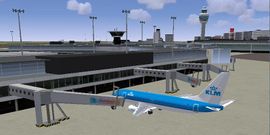FlightGear
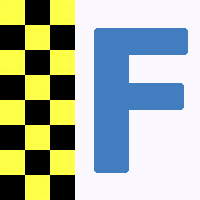 | |
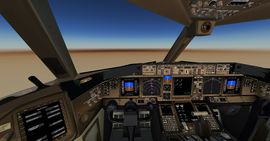 The cockpit of the Boeing 777-200ER | |
| Developed by | FlightGear developers & contributors |
|---|---|
| Initial release | July 17, 1997 |
| Latest release | 2024.1.3 (2 November 2025) |
| Written in | C, C++, Nasal |
| OS | Windows, macOS, Linux, and FreeBSD |
| Platform | Cross-platform |
| Development status | Active (1996-present) |
| Type | Flight simulator |
| License | GNU General Public License |
| Website | |
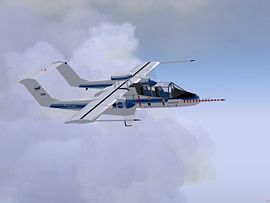
FlightGear Flight Simulator (often shortened to FlightGear or FGFS) is a sophisticated, free, and completely open-source flight simulator framework, created by volunteers. FlightGear is released under the terms of the GNU General Public License. FlightGear is mostly written in the C and C++ programming languages.
Increasingly detailed and realistic versions of FlightGear have been released every year since the project was started in 1996.
The latest public release is available as a free download, with easy to install packages for a variety of operating systems including Microsoft Windows, macOS, and Linux.
History
|
|
FlightGear development started with an online proposal in 1996, using custom 3D graphics code. Development of an OpenGL based version was spearheaded by Curtis Olson starting in 1997. Many people have contributed to the project in the years since its inception.
FlightGear incorporated other open-source resources, including the LaRCsim flight model from NASA, and freely available elevation data. The first working binaries, using OpenGL for 3D graphic code, came out in 1997. Enthusiastic development of newer versions for several years resulted in progressively more stable and advanced versions. By 2001, the team was releasing new beta versions regularly, and by 2005, the maturity of software lead to more widespread reviews, and increased popularity. 2007 marked a formal transition out of beta development with the release of version 1.0.0, ten years after FlightGear's first release in 1997.
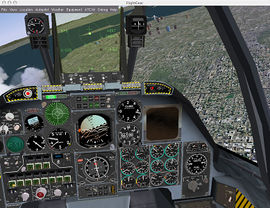
In 2008, version 1.9.0 of FlightGear included a major change from PLIB to OSG, which caused the temporarily loss of some features like 3D clouds and shadows, while newly added features, such as particles, imparted another degree of realism to the simulation.
Software
The simulation engine in FlightGear is called SimGear. It is used both as an end-user application and in academic and research environments, for the development and pursuit of flight simulation ideas.
This customizability of FlightGear is illustrated by the wide range of aircraft models that are available in FlightGear, from gliders to Helicopters, and from airliners to fighter jets. These aircraft models have been contributed by many different people.
The FlightGear aircraft in general use one of two main flight data models JSBSim and YAsim. Currently only one terrain engine is used, TerraGear. Weather effects include 3D clouds, lighting effects, and time of day.
Flight Dynamics Models
Flight Dynamics Models (FDM) are how the flight for an aircraft is simulated in the program. FlightGear uses a variety of internally written and imported flight model projects. Any aircraft must be programmed to use one of these models. Currently FlightGear is the only flight graphical flight simulator all the FDM are used for, and UIUC and YASim were developed specifically for FlightGear.
Early version used a FDM based on LaRCsim by NASA, which was replaced with more flexible FDM.
- JSBSim - the default flight dynamics model software since 2000.
- YASim - another FDM using different calculation method. Introduced starting in 0.7.9 in 2002.
- UIUC - developed by the UIUC Applied Aerodynamics Group at University of Illinois at Urbana-Champaign, also made use of LaRCsim. Once being widely used, it is nowadays longer included in FlightGear by default.
- FlightGear can also be setup to render using inputs from an external FDM source, such as from MATLAB.
- Other custom FDM for a specific aircraft type have been written, such as for lighter than air aircraft.
Aircraft
|
|
FlightGear started out with one aircraft included in NASA's LaRCsim, a Navion, which was replaced by a Cessna 172 by 2000. UIUC as well as JSBsim development brought several more aircraft with them, as did the development of YASim which have since become the main FDM used in FG. Over 400 aircraft in more than 900 unique liveries, are available for version 2.12, although only a few are included in the base package.
Scenery
|
|
FlightGear's world scenery project contains elevation and landclass data of the entire world. Objects -like terminals, windmills and bridges- are collected in the Scenery Database.
Networking and multi-display
Several networking options allow FlightGear to communicate with other instances of FlightGear. A multiplayer protocol is available for using FlightGear on a local network in a multi aircraft environment. This could be used for formation flight or control tower simulation. Multiplayer was soon expanded to allow playing over the internet. Other features include a Google maps based moving up that allows users to observe where other players are.
Several instances of FlightGear can be synchronized to allow for a multi-monitor environment. If all instances are running at the same frame rate consistently, it is possible to get good and tight synchronization between displays.
Applications and usages
|
|
FlightGear has been used and is being used in a wide range of projects in academia, industry (including NASA) and home-built cockpits.
External links
|
|
